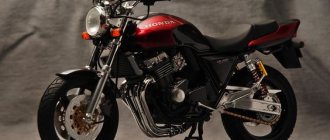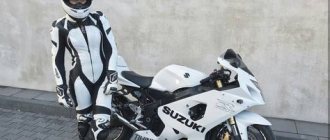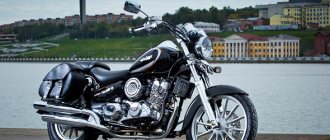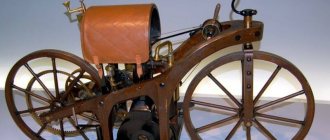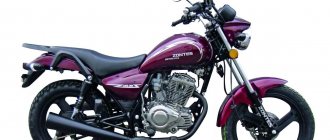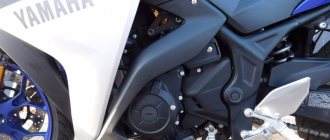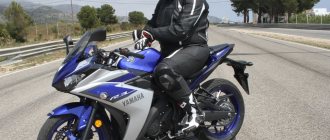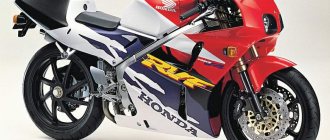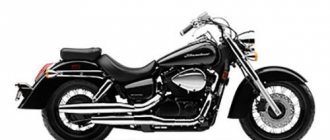Obedient and at the same time playful;
stylish but budget friendly; fast, but safe - the requirements for the first bike can contradict each other. And if the choice has been delayed, and the garage is still empty, you should pay attention to 400 cc motorcycles. Why are they better than their larger cubic-sized counterparts?
- Price. Let's put this indicative first place, because it is by price that we all filter products in any catalogues. Considering that you can take used equipment for training, and at the Japanese auction it will be without mileage in the Russian Federation, the choice in favor of a used “Japanese” is quite obvious.
- Weight. The first trips are also the first falls. The bike, which weighs a maximum of 170 kg, will not cause unnecessary inconvenience both when driving and in the process of lifting iron.
- Character. Yes, motorcycles have their own character, and the 400 models are distinguished by a fairly docile disposition. They do not provoke heroic deeds, but they also give 600cc a head start, accelerating to 200 km/h. quite capable.
- Appearance. The vast majority of four hundred configurations are manufactured by Japanese companies that know a lot not only about technical equipment, but also about creating an attractive, streamlined design.
Brief information
400 cc motorcycles began to be produced in Japan for the domestic market due to taxation regulations. Their power is no more than 53 hp. Later they gained recognition outside the country due to their low cost and ease of operation. Some Chinese factories have made attempts to repeat the success. However, Japanese bikes command complete trust from the public and remain beyond competition.
The best 400cc motorcycles for sports
The correct choice of the “iron horse” occupies an important place in teaching motorsports. It should be light and dynamic. And if you don’t believe in the capabilities of 250 cc sports bikes, you should pay attention to these “four hundred”:
- Honda CB 400 SF - according to owner reviews, this bike is easy to ride and reliable. It's not scary to ride it for the first time and it's easy to learn how to operate it. The CB 400 SF is equipped with a 4-cylinder 16-valve engine, the operation of which accelerates the design to 190 km/h. It is this model that is used for riding training in many motorcycle schools in Japan. The high-revving engine (9500-11000 rpm) is liquid cooled, has dual brakes at the front and a dual shock absorber at the rear. All this makes even daring driving quite confident and safe.
- Honda CBR 400 RR - the bike was produced from 1987 to 1999 and was a successor to the cross-country Honda CBR400 Aero. However, even today the exterior looks quite modern. “Adult” representatives, namely those that left the assembly line before 1993, produce 59 horsepower. Post-93 versions were produced according to updated Japanese legislation and provide 53 hp. Powering the bike is a 4-cylinder engine. The speed that can be reached is 180 km/h. Acceleration to 100 occurs in 4.5 seconds.
- Honda 400 X is a 400cc sports touring motorcycle introduced in March 2013. The two-cylinder engine produces 46 hp. and consumes 3.5 liters of gasoline per 100 km. Every year this Honda is updated, receiving upgrades in performance and appearance. In 2016, the bike is equipped with a higher windshield, adjustable suspension and steering wheel, as well as LED optics. Another year later, the exhaust system was improved here. Last updated March 22, 2019. Some of the changes: the ABS system has been improved, the steering angle has been increased by 6 degrees, the LCD panel now has clear visibility. The windshield has become 20 mm longer. The 400 X is available in two colors: Grand Prix red and matte black metallic.
008_MOTO_0810_024
| ■ The double-cable throttle is a small plus for a “real enduro.”■ The complex-shaped headlight contains a regular 35/35W Philips Duplo lamp; it was not possible to evaluate its performance in white night conditions.■ The closed steel frame and motor are painted black. The engine is very compact, but it is a pity that there is no kick starter. Very low cylinder. Access to the candle is easy. There is an electric fan.■ The saddle is one and a half, due to this the trunk is shifted forward. There is no space for tools under the saddle. |
The ambitions of the device in the niche of real enduro (which the “four hundred” from the domestic Japanese market have always been famous for) are declared by full-profile Kingstire tires (21 inches in the front, 18 in the rear). Their universal tread is made with a clear bias towards off-road, and its depth is decent: 12 mm on the rear wheel. The chain here is also endurable - the common 520, and with seals, which is atypical for the Chinese motorcycle industry. The one and a half hard saddle brings the motorcycle closer to hard enduro: sitting on this, you remember the joke about Lieutenant Rzhevsky and the frying pan. However, for the passenger there are quite comfortable handles on the sides of the trunk. But he will have to accept the fact that half of the sirloin will end up on the trunk. But on solo trips you can place a heavy load in the case above the rear wheel axle.
On the way from the metropolis to off-road spaces, I estimated the maximum speed: it was about 120 km/h (with a passenger). Perhaps after running in the device will run faster. But when landing directly and accelerating above 110 km/h, it starts to sail, and the pleasure of driving disappears. However, for light enduro this is rather the norm.
The dynamics in the city seemed sluggish for the declared 30 “horses”. This may be due to the lack of constant vacuum from the accelerator pump in the carburetor. However, it is expected that a Dell'Orto spool valve with a pump will be installed; such a sample was demonstrated in the showroom.
I was very pleased with the absence of vibrations throughout the entire range of engine operation. The gears are long, and at first it seemed that there were “no number of them” (there is not enough tachometer during spin-up). The sixth one was turned on after 90–100 km/h, it was used to save fuel during long-range driving. It is significant that the “neutral” was easily caught, even in static conditions, something that the gearboxes of other “more branded” motorcycles cannot boast of.
On broken gravel roads I finally appreciated the performance of the suspensions. There is a clear breakthrough by Chinese manufacturers - for a long time it was suspensions that were the weak point of off-road vehicles. On the coastal rocks of the Kronstadt forts we were able to fully experience the high ground clearance. And the fact that the first gear was “too high” meant I had to play with the clutch. The sand confirmed the correctness of the weight distribution, although the test on this surface cannot be fully described as it had rained the day before.
Road 400 cc motorcycles for the city and travel
Lightweight, small-capacity bikes are an excellent solution not only for sports, but also for city trips and even long trips.
This is proven by the TOP road models:
- Yamaha XJR 400 is a classic bike equipped with a 4-cylinder, 4-stroke, air-cooled engine. Over the 16 years that the model was produced, it went through a series of restylings. During this time, the torque indicator was increased to 38 Nm, a digital instrument panel was added, the gas tank volume was increased to 20 liters, and an immobilizer was added. Production ended with the introduction of new environmental standards, which the model no longer complied with. However, ready-made versions continue to be in demand, both at home and in the CIS countries.
- Yamaha Drag Star 400 is a cruiser with a 2-cylinder 4-stroke engine, cardan drive and 5-speed gearbox. It has a smooth ride and accelerates to one hundred in 11.2 seconds. At Japanese auctions you can also find lots with automatic transmissions. The touring Yamaha is designed for confident riding without aggression or super speed. Can accelerate to 135 km/h. This is a fairly economical version, consuming 2.28 liters. fuel every 100 km. It is distinguished by maneuverability due to the center of gravity shifted downwards and low weight (240 kg).
- Suzuki Gladius 400 is a naked bike with an elegant, discreet exterior. Equipped with a 4-stroke engine, ABS system, ISC (start at low temperatures), 6-speed gearbox, classic chain drive and friction clutch discs. Weighing 206 kg, the model consumes 2.5 liters of fuel per hundred. The triangular frame guarantees balance and confident handling. And the driver will need 5.6 seconds to accelerate the “iron horse” to hundreds. The manufacturer also took care of the passenger by equipping the seat with a comfortable handrail.
- Suzuki GSR 400 - after releasing the GSR 600 for export, Suzuki began producing a 400 cc motorcycle with similar characteristics, but for the domestic market. Equipped with an injector, 16-liter gas tank, aluminum frame, adjustable suspension. The 4-stroke engine has 4 cylinders and liquid cooling. The GSR 400 looks larger and more aggressive than its siblings, and is suitable for even tall drivers. Reliable and timely stopping is ensured by 4-piston brakes.
- Kawasaki ER-4N is a road naked version that is aesthetically and technically attractive. Allows you to drive at speeds up to 170 km/h. Considering the absence of a windshield, this is quite enough to make the driver feel comfortable. Equipped with a chain drive, injector, digital ignition, 15-liter gas tank, steel frame. In 5.5 seconds you can accelerate to hundreds. Due to its comfortable fit, the 209-kilogram road bike is suitable both for moving around the city and for long trips.
004_MOTO_0810_024
Having disassembled the engine, we were amazed at what a step forward the Chinese motor industry had made - both in design and technology.
Having disassembled the engine, we were amazed at what a step forward the Chinese motor industry had made - both in design and technology.
The steel space frame is powder coated black. However, everything else was painted in Henry Ford’s favorite color, except for the aluminum parts (pendulum, muffler, trunk, steering wheel, license plate bracket and rims). And it is proposed to expand the color range through self-adhesive ornaments.
As it should be on “correct” enduros, the electrical circuit of the ignition system includes sensors for side support and gear engagement. The ignition switch has a steering lock position, the tank cap is locked and there is a helmet lock on the side of the saddle - just like on the Japanese.
On the ascetic-looking dashboard there is a dial mechanical speedometer and a coolant temperature indicator. I think too much attention has been paid to the latter - it would be better if they installed a tachometer here. The latter is sorely lacking, especially considering the six-speed gearbox. There’s nothing to say about the controls, except that I’ll note the two-cable throttle handle - this is the first time I’ve noticed this on Chinese enduros (on others it’s par for the course).
There is a plug in place of the kick, which is a minus for enduro (although the kick can be installed as an option). However, you will find this on many modern devices. There were no problems with the electric start, and the engine responded quite loudly at idle.
It is not easy for a driver of shorter than average height to climb onto a motorcycle: the saddle height is 900 mm. This is the price for long-travel suspensions (280 mm) and ground clearance (300 mm). The rear suspension is progressive, with a linkage system. By the way, a revision of the “rocking chair” design showed: it was made in accordance with the canons - on needle bearings, with cuffs. The suspensions are quite modern: an “inverted” fork with compression and rebound adjustments and a monoshock absorber (gas-filled, but without a remote reservoir) with compression and spring preload adjustment (with a nut).
The brakes front and rear are two-piston, and the pads are interchangeable. No shortage is expected: the same type is used on Honda and KTM off-road vehicles. But the metal tube in the brake line of the front brake surprised me. Did you save money on a reinforced hose or were there deeper considerations? One way or another, there are no complaints about the brakes, as well as reasons for admiration.
Secrets of choosing 400 cc motorcycles
The best producers of this category of motor vehicles were and remain brands from the Land of the Rising Sun. And most importantly, the “four hundred” are not created for export. Where then do they appear on the roads of the Russian Federation and how to become the owner of this budget and dynamic bike? Japanese auctions come to the aid of everyone. A huge number of new and used motorcycles are available in the Synergosmoto catalog. All used models have no mileage on Russian roads.
Considering that this category of motorized transport for many is a transitional one before purchasing a heavy configuration, it is planned to ride it for a couple of seasons. This means that the price should be affordable. Lots on Synergosmoto are presented with an initial and probable sale price. Moreover, the price already includes delivery to your city. You can choose the bike you like, and entrust the paperwork to the company’s employees.
015_MOTO_0810_024
A paper air filter provides effective cleaning, but, unlike a serviceable foam filter, it is an extra item on the list of consumables.
A paper air filter provides effective cleaning, but, unlike a serviceable foam filter, it is an extra item on the list of consumables.
In conclusion, let’s talk about the identified shortcomings. There was no place for a tool or a small shmurdyak - the same “Japanese” have pencil cases, albeit small ones. In a tank designed for trips of up to 150 km, the level of gasoline is not visible. Short front fender. Maybe this is not so bad, but the radiator is not equipped with protection against dirt, and in the area where dirt escapes from under the front wheel there is also a sound signal. And at the end of the test it turned out that the plastic chain protection shield was wrapped and rubbed through.
In general, the device is certainly worthy and is not much different from the Japanese technology beloved by many. The only question that remains open is minor tuning such as engine protection or windshields, durability and availability of spare parts.
